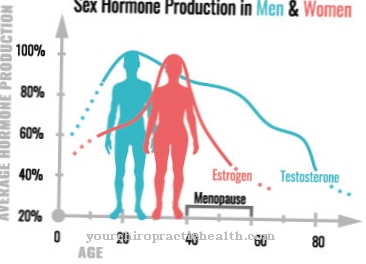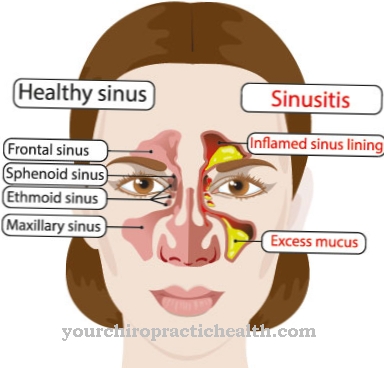Under the Dementia pugilistica medicine understands one traumatic encephalopathy with symptoms similar to Parkinson's disease. The disease is particularly common among boxers and other people who are often hit on the head. There is currently no causal therapy.
What is dementia pugilistica?

© Dmitry Ersler - stock.adobe.com
The dementia pugilistica is also called chronic traumatic encephalopathy, fist fighting Parkinson's syndrome or Boxer syndrome known. This neurological disorder mainly affects people who have to endure blows or bumps to the head area. The disease is particularly common among boxers, football players and other professional athletes.
However, drug addicts or alcohol addicts are also more likely to be affected, as they fall more often and regularly hit their heads. Jack Dempsey is one of the most famous patients of dementia pugilistica among boxers. In the NFL, names like Chris Henry are associated with the disease. The disease usually builds up over a number of years and often starts at just 16 years of age. So far, the disease with its causes and course forms has not been conclusively researched.
causes
To date, the exact causes of dementia pugilistica have not been conclusively clarified. Since the phenomenon occurs more frequently in boxers, the medicine assumes that the cause is hard blows to the head area. The loss of brain cells apparently plays just as important a role in the clinical picture as traumatic damage to the cerebellum and scarring on the brain mass. Scar tissue in the central nervous system makes it difficult, among other things, to transmit stimuli.
Ultimately, all scarred areas of the brain lose their original function. As long as the affected areas only correspond to limited areas, the loss of function of the cells is compensated for by the surrounding tissue. Such compensation is no longer possible with larger scar areas. Medicine is still largely unclear why not all boxers get dementia pugilistica. A definitive connection with boxing has not yet been proven. There is no doubt that dementia pugilistica is an acquired disease.
You can find your medication here
➔ Medicines to calm down and strengthen nervesSymptoms, ailments & signs
On the outside, the symptoms of dementia pugilistica are reminiscent of Parkinson's disease. The tremor is one of the leading symptoms of this disease. The severity of the tremor varies from case to case. Usually, there are additional gait uncertainties. These phenomena also often lead to difficulties in coordination. Usually, the ability to coordinate decreases noticeably as the disease progresses.
These symptoms are sometimes accompanied by the classic symptoms of dementia, such as a slow decay of memory and personality. Normally, behavior in everyday life also changes as a side effect. Patients often react to everyday situations with actions or emotions that are difficult to understand.
Psychological symptoms also occur. For example, those affected often suffer from persistent depressive moods. Apart from that, the ability to speak can be impaired. Severe language problems are often even described as a leading symptom.
diagnosis
The anamnesis plays a decisive role in the diagnosis of dementia pugilistica. If the anamnesis suggests increased blows to the head in the case of the main symptoms described, the neurologist will probably have an initial suspicion. Diseases such as dementia and especially Parkinson's must be taken into account in the differential diagnosis.
An MRI of the skull shows increased scarring, which can be another indication of the clinical picture. In boxers, the first symptoms usually appear around 20 years after the causal head trauma. The course of the disease can be influenced individually to a certain extent and possibly even by the psychological constitution of the patient.
Complications
In most cases, dementia pugilistica leads to tremors and thus to what is known as tremor. This can extremely reduce the patient's quality of life and make everyday life more difficult for the patient. Ordinary activities are no longer possible, so that the patient can also suffer from mental illness and depression due to the limitations.
There are also uncertainties when running, which are accompanied by coordination disorders. Patients can no longer correctly assess distances and routes. The ability to speak can also be restricted, which is mainly reflected in a word finding disorder.
It is not uncommon for the patient to then rely on the help of other people in everyday life. The relatives can also be stressed by dementia pugilistica. A causal treatment of dementia pugilistica is unfortunately not possible. Therefore, only the symptoms can be limited somewhat in order to make everyday life tolerable for the patient.
Above all, therapies and speech therapy are planned. Depression can often be limited by talking to a psychologist or with the help of medication. Life expectancy decreases due to the disease.
When should you go to the doctor?
Unfortunately, dementia pugilistica cannot be completely cured or limited. However, an early diagnosis can help improve symptoms, so medical treatment is definitely required for this condition. A doctor must then be seen if the person has a tremor. Uncertainties in gait can also indicate the disease and must be examined. Coordination disorders in particular are common in dementia pugilistica and are a common symptom.
Furthermore, the dementia must be diagnosed and treated by a doctor. This can make the everyday life of those affected and their relatives much easier. Sudden upset moods or depression can also indicate this disease. A doctor should also be consulted here. The diagnosis of this disease can usually be made by the general practitioner. Further treatment is carried out by various specialists and is usually based on the patient's condition. Unfortunately, a complete cure cannot yet be achieved.
Doctors & therapists in your area
Treatment & Therapy
According to the current state of medicine, damage to the central nervous system cannot be reversed. Treatment of the causes of dementia pugilistica is therefore not possible. The disease is therefore an incurable, long-term consequence of nervous systematic trauma. Despite the incurability and unstoppable course of the disease, at least some symptoms of the disease can be treated.
As with all incurable diseases, the primary goal of supportive therapy is to improve the quality of life. When nerve tissue dies, the surrounding nerve cells can learn through training to take over the tasks of the defective cells. This phenomenon is known not least from the therapy of stroke patients and can also play a role in the treatment of dementia pugilistica.
In the case of gait disorders, physiotherapeutic treatments can, for example, serve to compensate and thus improve the patient's quality of life. The same applies to occupational therapy treatments, which ideally reduce the tremor. Speech disorders can in turn improve in speech therapy support.
In order to learn to deal with the disease and to improve one's own emotional state, physiotherapy sessions are often recommended. A stable psyche can presumably have a positive influence on the course of the disease. However, drug therapies can also be used against particularly severe depression.
Outlook & forecast
The prognosis for dementia pugilistica is generally unfavorable. Although there are influencing factors that have a positive effect on the course of the disease, there is no cure. Dementia pugilistica runs slowly over many years and decades. The symptoms develop gradually and are only associated with dementia pugilistica at a late stage. During this period there is usually no treatment due to a lack of diagnosis.
If the person concerned avoids martial arts and other blows to the head, the progression of the disease can be influenced. In addition, speech therapy therapies help to improve speech.Nevertheless, permanent scars have formed in the brain, which can lead to a further deterioration in health at any time. Since the causes of dementia pugilistica have not yet been conclusively clarified, there is no uniform treatment option. What is certain is that the absence of blows to the head has a positive effect on health.
If psychological problems arise in addition to dementia pugilistica, the prospect of relief deteriorates considerably. The quality of life is severely limited and the lifespan is usually shortened. Gradually, unsteadiness occurs. In the further course, the patient needs daily care and support in order to be able to cope with everyday life.
You can find your medication here
➔ Medicines to calm down and strengthen nervesprevention
Since dementia pugilistica is an acquired disease, the phenomenon can be prevented as far as possible. Those who avoid blows and bumps to the head and have head trauma treated promptly will probably not get sick from the phenomenon.
You can do that yourself
In order to deal with the disease Dementica pugilistica human, an assessment of the degree of the disease should first be made. This makes it possible to determine which treatment options are useful. If possible, the sick person should talk about it with those around him. Better decisions can be made together, and relatives or friends may already have had good experiences with doctors or therapies.
Speech therapy, for example, stabilizes and expands language skills. With the help of physiotherapy, sick people can train their motor skills again. Sick people can also inquire at the city or municipality or on the Internet whether there are self-help groups near where they live. There should be people who exchange certain experiences with each other and thus convey advice, experience and contact points with the help of social workers and guided conversations.
The sick person should also consciously describe objects, take them in hand, look at the peculiarities from all sides, feel the surface, think about what the object can be used for, and if possible also pronounce these impressions aloud, or better still, write them down. With the help of a dictionary or with acquaintances or relatives, the vocabulary can be expanded, and the emotions are connected with the right objects. Rooms, plants, animals, time, daily events, everything should be recognized and named as consciously as possible. The objects should then be returned to the place from which they were taken, if possible.



.jpg)























